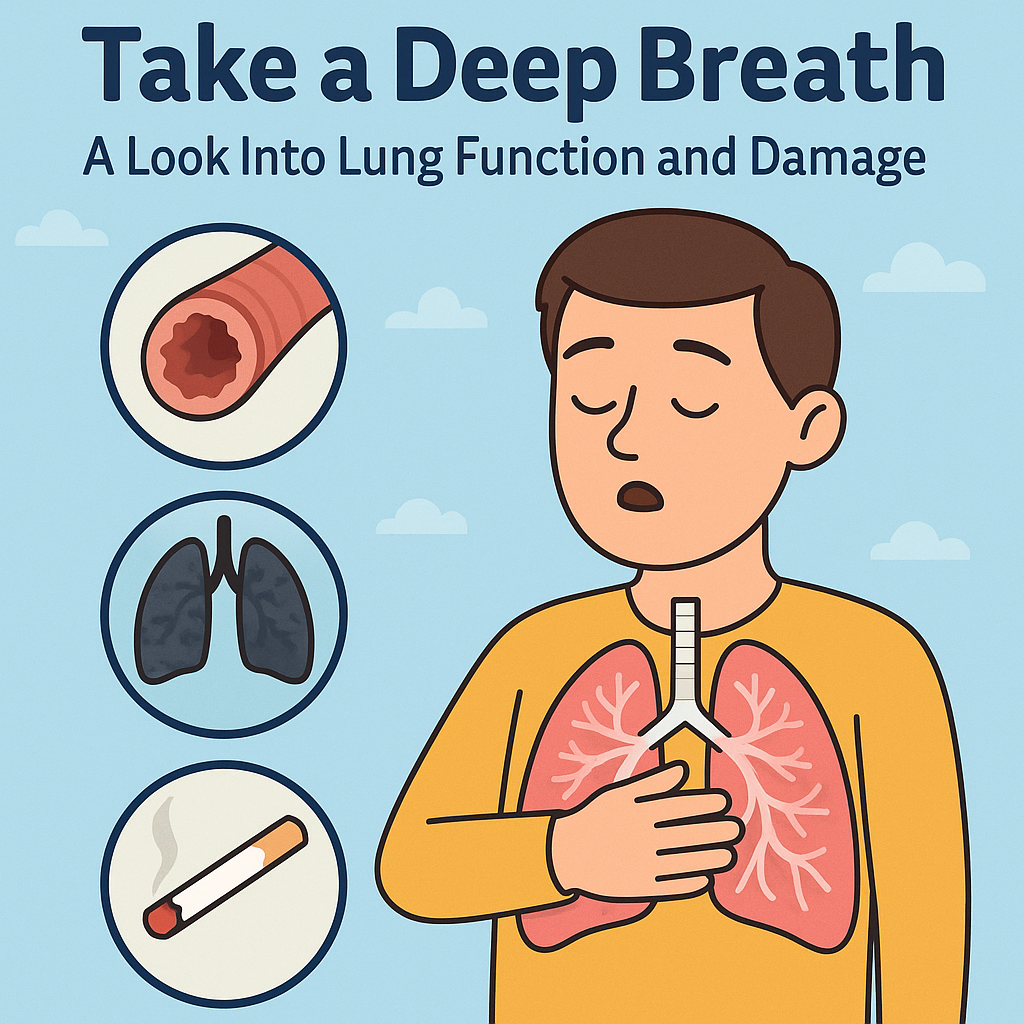Take a Deep Breath – A Look Into Lung Function and Damage

By the Varrock Street Journal Health & Science Team
Have you ever stopped to think about how often you breathe each day? (Hint: it's over 20,000 times.) And yet, many of us know surprisingly little about how the lungs function—or what happens when things go wrong. In this week’s edition, we’re diving deep into lung physiology, highlighting major respiratory diseases like asthma, COPD, bronchitis, and mesothelioma, and taking a hard look at how smoking impacts these delicate, vital organs.

🧬 Understanding Lung Physiology
The lungs are two spongy, air-filled organs nestled within the chest cavity. When you inhale, air travels through your trachea into branching tubes called bronchi, which lead to even smaller passages called bronchioles. These end in tiny air sacs called alveoli, where oxygen is exchanged for carbon dioxide through the blood. This gas exchange is critical—oxygen fuels every cell in the body, and carbon dioxide must be expelled to maintain proper blood chemistry.
The lungs are supported by the diaphragm (a dome-shaped muscle beneath the lungs), as well as surrounding ribs and muscles, working together to allow for expansion and contraction. Healthy lungs are resilient, self-cleaning, and highly efficient. But various pathologies can disturb this system.
Here is a quick video showing the physiology behind how our lungs work!
🩺 Common Lung Pathologies
Asthma
Asthma is a chronic inflammatory condition that causes the airways to narrow and swell, often producing excess mucus. Triggers like allergens, cold air, or exercise can lead to shortness of breath, wheezing, and coughing. Asthma is manageable with inhalers (bronchodilators and corticosteroids), but in severe cases, it can be life-threatening.
Chronic Obstructive Pulmonary Disease (COPD)
COPD includes chronic bronchitis and emphysema and is primarily caused by long-term exposure to irritants—most commonly cigarette smoke. It leads to airflow obstruction and destruction of alveoli. People with COPD experience chronic cough, sputum production, and dyspnea (shortness of breath). It’s progressive and incurable but can be managed with oxygen therapy, medications, and lifestyle changes.
Bronchitis
There are two types: acute (often caused by viruses) and chronic (more serious, often related to smoking). Bronchitis inflames the bronchial tubes, causing coughing, mucus production, and chest discomfort. Acute cases typically resolve, but chronic bronchitis is part of COPD and can significantly affect lung function.
Mesothelioma
A rare but aggressive cancer, mesothelioma develops in the pleura—the thin lining surrounding the lungs—and is most often linked to asbestos exposure. Symptoms include chest pain, shortness of breath, and unexplained weight loss. It has a poor prognosis due to late diagnosis, but early detection and emerging therapies offer hope.
🚬 The Lung-Damaging Legacy of Smoking
Smoking is the leading preventable cause of lung disease. The toxins in cigarette smoke damage the airways, destroy alveoli, impair immune defenses, and create a high risk for nearly every pulmonary pathology—especially COPD and lung cancer.
Each puff introduces thousands of harmful chemicals that:
- Break down the elastic walls of alveoli (emphysema)
- Increase mucus production (chronic bronchitis)
- Paralyze cilia, preventing the lungs from self-cleaning
- Lead to genetic mutations, increasing cancer risk
Even secondhand smoke can cause long-term damage, especially in children and older adults. Fortunately, research shows lung health begins to improve within weeks of quitting, and the risk of cancer drops substantially over time.

📉 Why This Matters
Your lungs fuel every organ in your body with oxygen. Damage here isn't isolated—it ripples through your entire health profile. Learning to identify symptoms early, understanding risk factors, and quitting smoking (or never starting) are the best strategies to protect your future breathing power.
🔍 Spotlight on Prevention and the Future
- Vaccinations (flu and pneumonia) help prevent respiratory infections that can worsen lung conditions.
- Indoor air purifiers and reduced exposure to allergens, mold, and pollution may benefit people with asthma or COPD.
- Pulmonary rehabilitation programs are expanding to help patients regain quality of life after diagnosis.
- Research on regenerative therapies and lung transplants is offering hope for irreversible damage.
🧠 Final Thoughts
The lungs may work quietly in the background, but they’re at the heart of every breath, every moment. Whether you're managing a condition or just want to stay informed, taking care of your lungs is one of the most valuable things you can do for your health. So maybe next time someone lights up a cigarette near you, you’ll remember the cost your lungs might pay.
One topic we didn't cover, but still important to lung physiology!
📚 References
- American Lung Association. (2024). Learn about lung health and diseases.
- CDC. (2023). Smoking & Tobacco Use.
- Mayo Clinic. (2023). Asthma and COPD.
- Mesothelioma Research Foundation. (2024). Mesothelioma overview.
- WHO. (2024). Air Pollution and Health.
